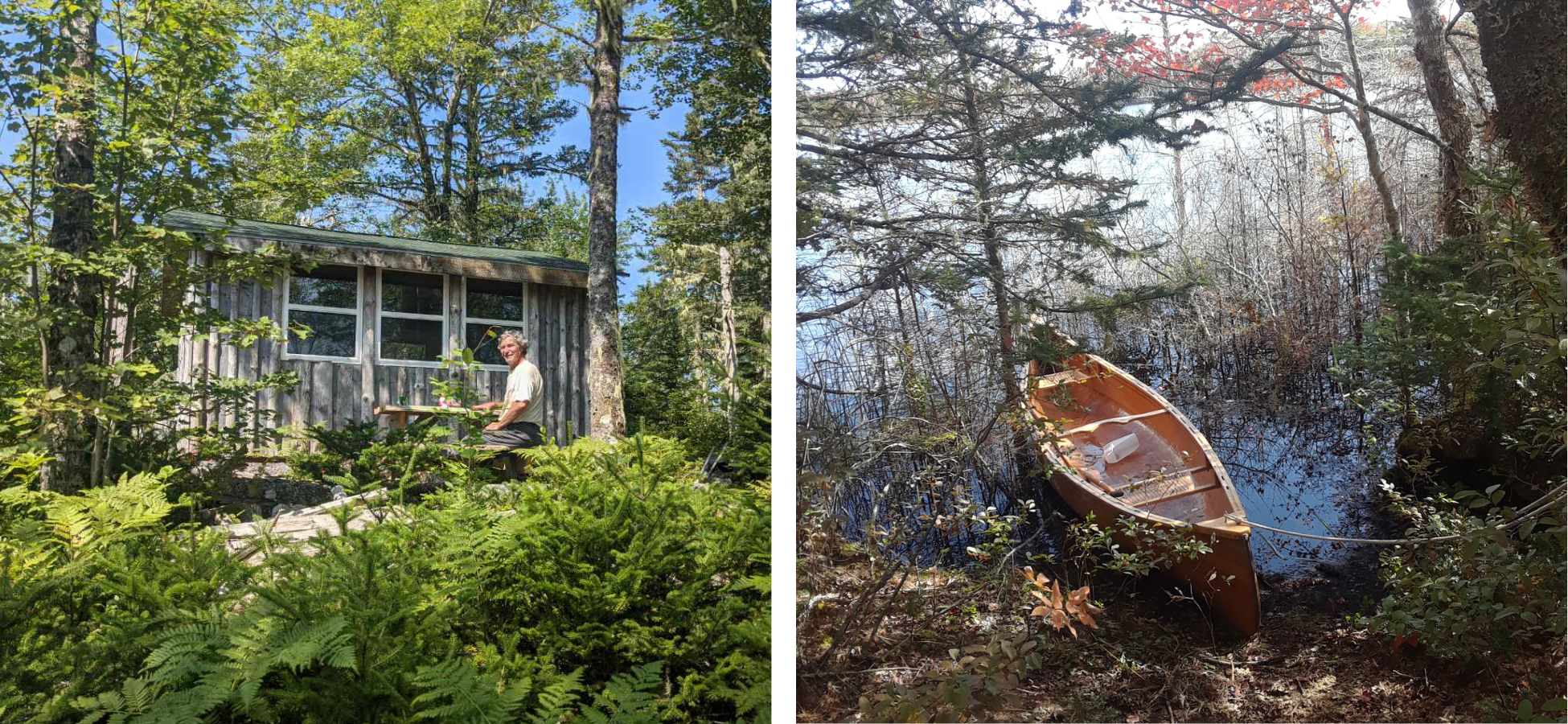Balancing Forestry and Conservation: Cindy and Sherm’s Story
It started with a simple note written on a map of Carman Pierce’s 430-acre woodland: ‘Could be a great spot for a camp.’ Carman's dream of building the camp on his woodland near Sable River never came to fruition, but decades later, his daughter Cindy and her husband Sherm Embree turned that vision into a reality.
Tucked away in the eastern corner of the woodland near Johnston’s Pond is a small and humble backwoods camp that Sherm built with the help of his family and friends. It’s become a special place where the Embrees have spent countless hours hiking, paddling, and enjoying the wilderness.
“We have so many memories in the woodland, and at the camp,” says Cindy. “It’s where we learned to canoe and row, and that was a big part of our lives. ”
The eastern corner of the woodlot, where the camp is located, is rich with wildlife and natural diversity. Balsam fir and black spruce make up the canopy, leaving lots of sunlight that allows lichen and shrubs, including inkberry and bayberry, to thrive. Recognizing the ecological importance of this area, the Embrees have designated it a ‘Conservation Zone’ within their NSWWT easement. This protected area restricts land use to safeguard its natural state and ecological integrity.
“There are about 80-100 acres that Cindy’s father had left untouched,” says Sherm. “There are rare lichens and you can tell that the trees are between 120 to 150 years old. We haven’t had any forestry equipment or ATVs in there, and we want to ensure this area continues to be protected.”
The Embree’s woodland is an excellent example of what effective ecological forestry can look like and how forestry and conservation can work together to balance the multiple values of woodland stewards.
In the same 1979 management plan that suggested a potential site for a camp, several areas were also identified as suitable for timber harvesting. Carman, Cindy’s father, carried out selection harvesting in the 1980s, carefully balancing resource use with sustainability. Since taking over the woodland, Cindy and Sherm have continued this practice, adhering to the same principles of responsible forestry to ensure the health and longevity of the woodland.
“Through the management plan, we have designated conservation zones, working forest zones and an agricultural zone,” says Sherm.
“We see the woodland much like a garden. We want it to be productive and sustainable while also respecting conservation and protecting critical areas.”
The agricultural zone includes a small 7-acre Christmas tree lot and work camp, another favourite spot on the woodland that Carman established back in 1979. When Cindy and Sherm first took over the Christmas tree lot from Carman, they thought it could be a way to earn some money, but they quickly realized it would take a lot more land and resources to provide a family income.
"For us, it turned out to be very much a lifestyle, and it allowed us to connect to the whole surrounding community,” says Cindy. “People come with their families, and we get to know their kids and their dogs.”
“Because we’ve been doing it for more than 20 years, we’ve seen babies born and watched kids grow up - and that’s all because of the Christmas tree lot.”
Over time, the Christmas tree lot became a beloved tradition, not just for their family but for the surrounding community too. Families return year after year to pick out their holiday trees, sharing stories and creating memories that continue to span generations.
Sherm and Cindy are watching the community slowly evolve as neighbouring woodlands change ownership.
“Historically, most people have always either stayed in the community or come back because they had a family connection; those were the people who came to the community hall and were engaged with the community itself,” says Cindy.
“We’re seeing lots of people moving rurally without really understanding what that means, and the importance of building a community that looks out for each other.”
The changing dynamics of their community have strengthened Sherm and Cindy’s purpose to preserve their values and the land they cherish. This desire drives their careful planning for the future, ensuring that the woodland remains a part of their family heritage and a resource for generations to come.
“There's no doubt that the woodland is going to stay within the family. But our kids have their own lives and careers, and we’re not sure if they will be able to come down and live on the property full-time,” says Sherm. "So, succession planning is a big part of why we joined both the Western Woodlot Services Cooperative and Nova Scotia Working Woodlands Trust.”
Sherm and Cindy had been approached by conservation organizations in the past but didn’t feel like they were a perfect fit. While they wanted to preserve some areas for conservation, they also wanted to continue some light harvesting and silviculture. When they heard about the Nova Scotia Working Woodlands Trust - an organization that would allow them to combine their passions for sustainable forestry and conservation - they were thrilled.
“Just the title of the organization was really exciting to us; the fact that it had ‘working woodlands’ in it,” says Sherm.
“Prior to NSWWT, there were forestry organizations, like Western Woodlot Services Cooperative, and conservation organizations, but the Nova Scotia Working Woodlands Trust really reaches between those two, pulling together conservation, forestry and sustainability. ”
By thoughtfully combining sustainable forestry with protected conservation zones, Cindy and Sherm have created a model for what it means to steward the land with both purpose and heart. Their partnership with the Nova Scotia Working Woodlands Trust ensures that this remarkable space will continue to thrive, not just as a haven for wildlife and natural diversity but also as a source of cherished memories and community tradition for generations to come.




